Introduction
- SARS is a coronavirus, first identified in 2003, that emerged from an uncertain animal reservoir.
- Symptoms: high fever, cough, lung inflammation, chills, headaches, muscle aches, etc. (SA Health, 2012).
- Epidemics originated in the Guangdong Province of China in 2002 and, in 2003, spread to over 30 countries, including Singapore.
- Singapore epidemics: 238 probable cases of SARS, 8 imported cases, and 33 deaths.
Severe Acute Respiratory Syndrome (SARS) is a recently emerged viral disease associated with severe symptoms of distress in the lower respiratory tract. According to Abdullah, Tomlinson, Cockram, and Thomas (2003), the first outbreak originally occurred “in November 2002 in the Guangdong Province of China and, by February 2003, had spread to Hong Kong and subsequently to 32 other countries or regions, infecting approximately 8,459 patients and resulting in >800 deaths” (p. 1042). The SARS epidemic under discussion actively progressed in Singapore from March until May 2003, resulting in 238 probable cases of the infection, 8 imported cases, and 33 deaths (Goh et al., 2006). At the present moment, the possibility of a SARS outbreak is considered to be adequately contained both in the country and within the region in general. However, the related bio-safety concerns remain.
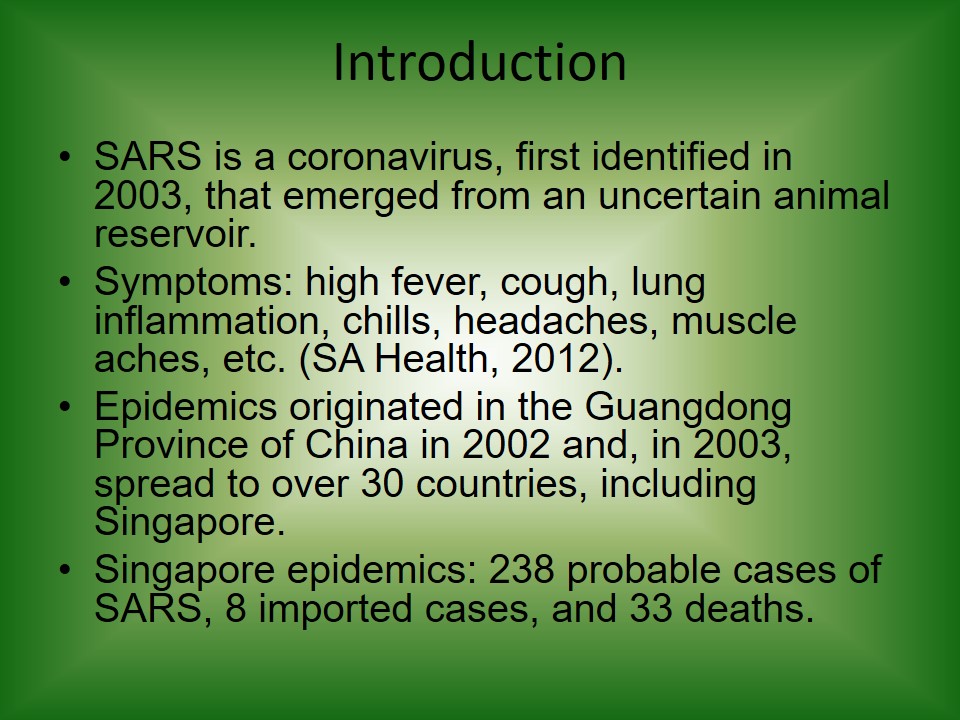
Causes: Individual, Community, and Cultural Levels
- Individual level:
- SARS is spread through animal-to-human and human-to-human interactions.
- Community level:
- Multigenerational family structure leads to greater SARS exposure due to frequent contact with family members.
- Health practitioners face a greater risk of infection.
- Cultural level:
- Singapore has a high number of traditional wet markets.
In their 2004 study, Peiris, Guan, and Yuen stated that SARS is caused by “a previously unrecognized animal coronavirus that exploited opportunities provided by ‘wet markets’ in southern China to adapt to become a virus readily transmissible between humans” (p. S88). The researchers observed that many of the first individuals to be affected were involved to some extent in the live-game trade (Peiris et al., 2004). These findings indicate a probable interspecies path for the virus’s transmission and suggest that people involved in work with live and dead animals (for example, farmers, butchers, and market vendors) may face the threat of exposure to the virus. At the same time, at the micro and macro community levels, SARS can be spread through human-to-human interactions. For example, the virus is reported to be prone to “cause clusters of disease in families and healthcare workers” (Peiris et al., 2004, p. S88), meaning that densely inhabited households and public settings with a high inflow of people are at greater risk of SARS transmission.
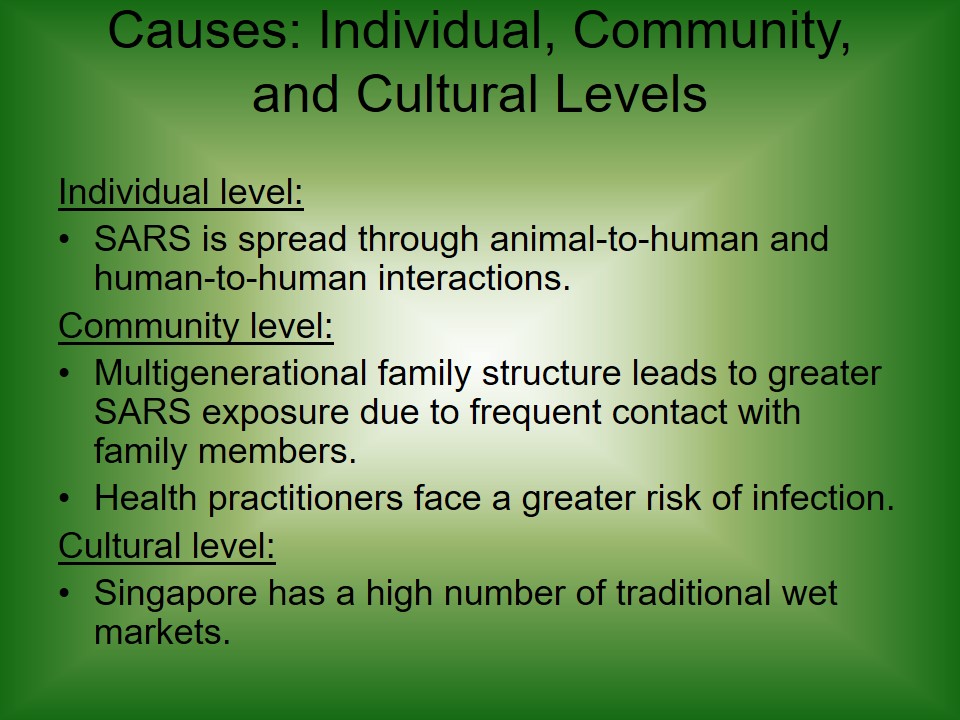
Causes: Environmental Level
- SARS is characterized by high environmental resistance.
- The virus survives in biological fluids (respiratory secretions or feces) (Geller, Varbanov, & Duval, 2012).
- Its infectivity maintains in a relatively humid (50–70%) and warm climate (4–37°C) (Geller et al., 2012).
SARS is associated with a significant environmental resistance, which means it can be transmitted by way of surfaces as well. For example, the investigation of the index case in Singapore (a previously healthy young woman) revealed that the virus could be spread through indirect contact with contaminated biological fluids. The affected woman stayed in a hotel in Hong Kong during the epidemic along with a Chinese physician who was considered to be the source of infection (Hsu et al., 2003). She was consequently admitted to a hospital in Singapore with severe pneumonia-like symptoms and thus could have caused the further spread of the disease because, at that time, the highly infectious nature of SARS was not known (Hsu et al., 2013). Moreover, viral infectivity is better preserved in environments with 50% relative humidity and a temperature between 4°C and 37°C (Geller, Varbanov, & Duval, 2012). The evidence suggests that desiccation may help reduce the chance for virus survival considerably.
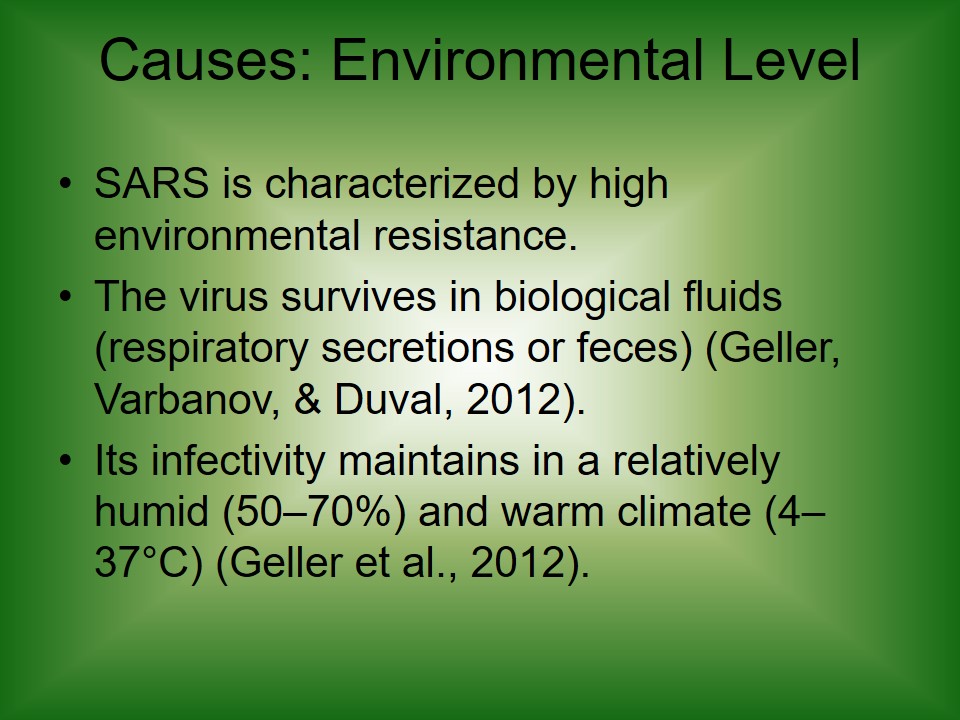
Factors of Exacerbation: Environment and Healthcare
- No treatment options for SARS exist in modern medicine.
- The virus is resistant to disinfection.
- High population density as well as a tropical rainforest climate in Singapore may aggravate the situation in the country in the case of a new epidemic.
Currently, no data exists regarding an ongoing transmission of the virus in Singapore or elsewhere, and it is not clear if the SARS epidemic will ever be repeated. Nevertheless, some factors, mainly environmental and healthcare-related, may contribute to the exacerbation of SARS. First, it is important to note that no effective treatment options for the virus currently exist, and the majority of antiseptics showed insignificant effectiveness in decreasing SARS infectivity (Geller et al., 2012). Second, Singapore is the third most densely populated county in the world with 8,274 of people per square kilometer (“Countries in the world by population,” 2018). Along with these factors, the country’s tropical rainforest climate, which is warm and humid, increases the risk for fast transmission of SARS at both the individual and community levels.
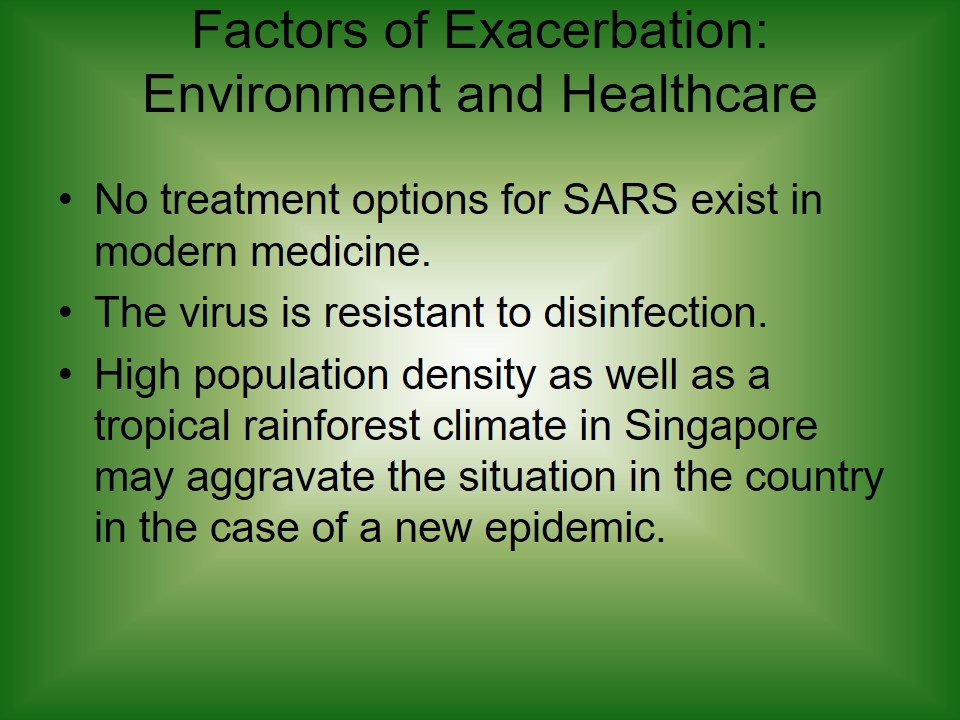
Factors of Exacerbation: Individual and Social-Cultural Levels
- Individual level:
- Health beliefs and individual health-seeking behaviors define one’s health prognosis and infection risks.
- Social-cultural level:
- Some population groups have limited access to healthcare and show reduced health literacy levels.
At the individual level, a physiological factor such as the development of neutrophilia due to infection is associated with poor patient outcome in the case of SARS (Leong et al., 2006). Not only may it be caused by a high viral load exposure but also by an individual’s health-seeking behaviors. For instance, while it is reported that many young individuals tend to avoid referring to hospitals when experiencing mild symptoms, a significant percentage of adults with a positive economic status, sufficient educational level, and favorable housing conditions in Singapore tend to play an active role in seeking treatment (Chan, Lee, & Low, 2018). The situation is different in less-advantaged populations, as well as in the case of immigrant workers, who usually show a limited awareness of available healthcare service options and are associated with a reduced level of access due to financial and other constraints (Ang et al., 2017).

Action Plan
- Education:
- Convey messages that may positively influence individuals’ health-related behaviors.
- Provide relevant training for medical personnel to increase their SARS prevention, diagnosis, and treatment skills.
- Communication:
- Use satellite broadcasts and webcasts to review infection control practices, level of community containment, and more.
- Epidemic relief:
- Develop local networks that would promote community resiliency during SARS.
- Practice desiccation of settings and quarantine.
- Technology:
- Research and develop new effective vaccines and antiviral agents.
Any action plan devoted to the prevention and elimination of SARS epidemics should focus on the identified risk factors. According to Person et al. (2004), “fear of being socially marginalized and stigmatized as a result of a disease outbreak may cause people to deny early clinical symptoms and may contribute to their failure to seek timely medical care” (p. 360). Therefore, community education should aim to positively influence individuals’ health-related behaviors. For example, one recommendation would be to convey ethical and culturally-sensitive messages through media and web resources. Moreover, since most healthcare practitioners lack sufficient experience in dealing with SARS, appropriate training in the diagnosis, prevention, and treatment of the virus must be provided as well.
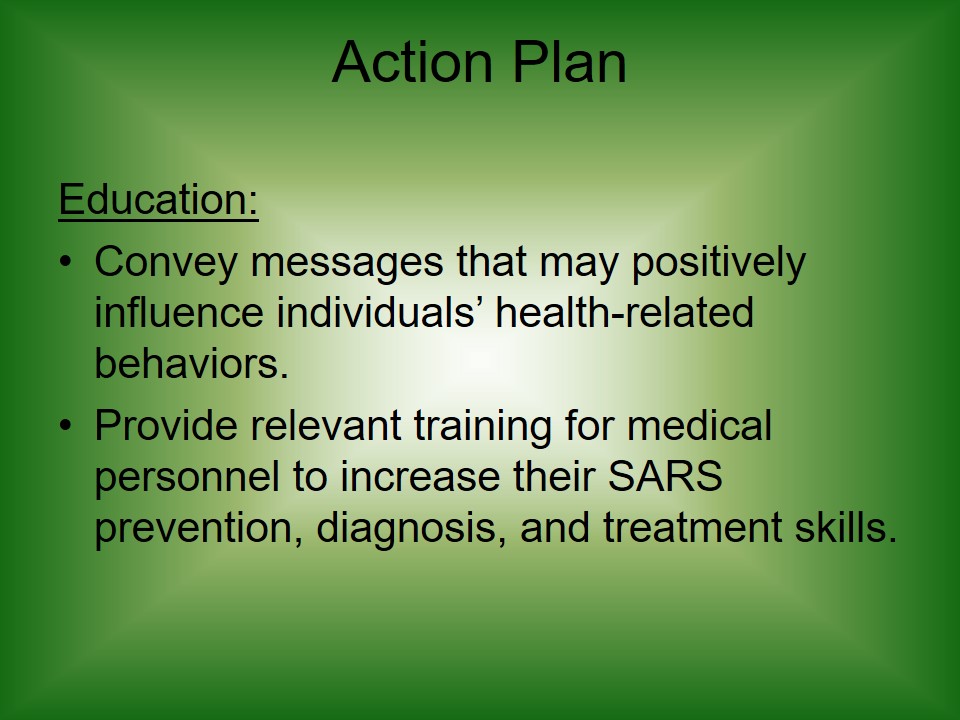
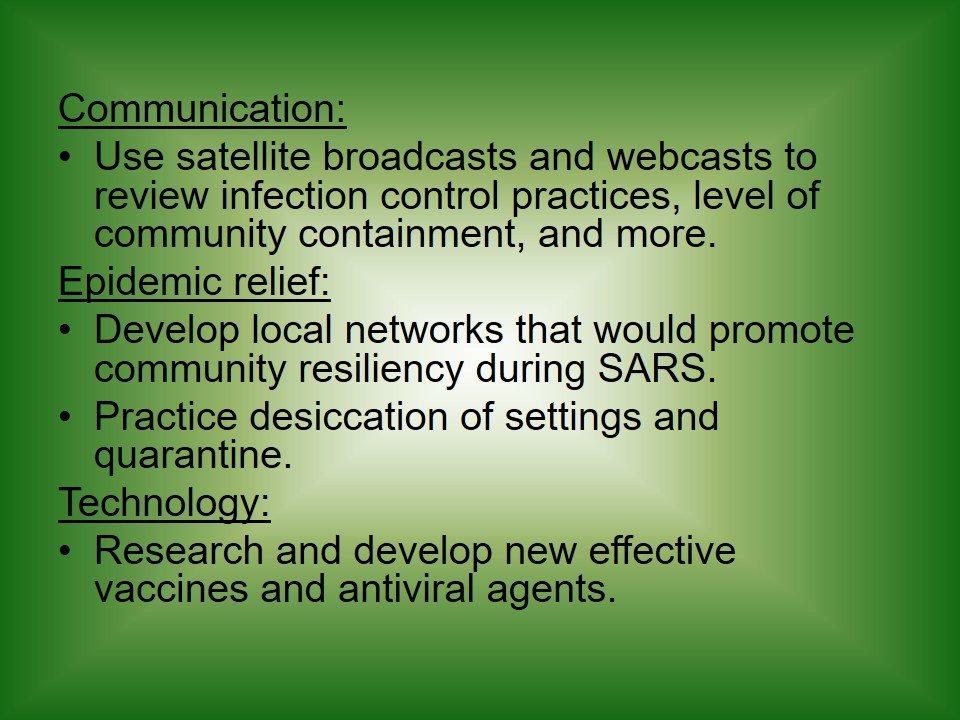
References
Abdullah, A. S. M., Tomlinson, B., Cockram, C. S., & Thomas, G. N. (2003). Lessons from the severe acute respiratory syndrome outbreak in Hong Kong. Emerging Infectious Diseases, 9(9), 1042–1045.
Ang, J. W., Chia, C., Koh, C. J., Chua, B. W. B., Narayanaswamy, S., Wijaya, L., … Vasoo, S. (2017). Healthcare-seeking behaviour, barriers and mental health of non-domestic migrant workers in Singapore. BMJ Global Health, 2(2), e000213.
Centers for Disease Control and Prevention. (2005). SARS educational tools and resources. Web.
Chan, C. Q. H., Lee, K. H., & Low, L. L. (2018). A systematic review of health status, health seeking behaviour and healthcare utilisation of low socioeconomic status populations in urban Singapore. International Journal for Equity in Health, 17(39), 1-21.
Countries in the world by population (2018). (2018). Web.
Geller, C., Varbanov, M., & Duval, R. E. (2012). Human coronaviruses: Insights into environmental resistance and its influence on the development of new antiseptic strategies. Viruses, 4(11), 3044-3068.
Goh, K. T., Cutter, J., Heng, B. H., Ma, S., Koh, B. K. W., … Chew, S. K. (2006). Epidemiology and control of SARS in Singapore. Annals of the Academy of Medicine, Singapore, 35(5), 301-316.
Hsu, L.-Y., Lee, C.-C., Green, J. A., Ang, B., Paton, N. I., Lee, L., … Leo, Y.-S. (2003). Severe acute respiratory syndrome (SARS) in Singapore: Clinical features of index patient and initial contacts. Emerging Infectious Diseases, 9(6), 713-717.
Leong, H. N., Earnest, A., Lim, H. H., Chin, C. F., Tan, C. S. H., Puhaindran, M. E., … Leo, Y. S. (2006). SARS in Singapore – Predictors of disease severity. Annals of the Academy of Medicine, Singapore, 35(5), 326-331.
Peiris, J. S. M., Guan, Y., & Yuen, K. Y. (2004). Severe acute respiratory syndrome. Nature Medicine, 10(12), S88-S97.
Person, B., Sy, F., Holton, K., Govert, B., Liang, A., Garza, B., … Zauderer, L. (2004). Fear and stigma: The Epidemic within the SARS outbreak. Emerging Infectious Diseases, 10(2), 358-363.
SA Health. (2012). Severe acute respiratory syndrome (SARS) – Including symptoms, treatment and prevention. Web.